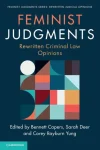Feminist Judgments: Rewritten Criminal Law Opinions
 Editors: Bennett Capers, Sarah Deer & Corey Rayburn Yung
Editors: Bennett Capers, Sarah Deer & Corey Rayburn Yung
Publisher: Cambridge University Press, 2022. 328 pages.
Reviewer: Kimberly D. Bailey
During a time when legislatures are passing laws limiting the discussion of race, gender, and other identities in school curriculums, it is an understatement to assert that Feminist Judgments is both timely and important. While this book was not written in direct response to the current political moment, it is still highly relevant in that it suggests that the solution to current inequities in the law is not to erase discussions of marginalized identities; instead, Feminist Judgments points to that fact that, when analyzing legal issues, judges need to spend more time considering the diverse personal experiences of marginalized individuals. This type of analysis is especially critical because these experiences are often very different from the experiences of those who tend to gain the privilege of becoming judges. Moreover, the concerns of marginalized individuals are particularly salient whenever they are forced to interact with the American criminal justice system, which is brutally punitive. Unfortunately, the law often falls short when it comes to both addressing the harms that women suffer when they are the victims of crime and ensuring that women are treated equitably and fairly as criminal defendants.
Feminist Judgments, however, ably and persuasively suggests that there could be a more equitable and fairer reality. Critiquing seminal criminal law cases, the book is organized into two separate parts. Part I, “Gendered Justice,” provides a feminist perspective to cases in which the gender dynamic within the case is not necessarily obvious. Part II, “Gender on Trial,” addresses cases in which the gender identity of the complainant or defendant is central to the facts of the case. In addition, each case is evaluated by two separate authors. Through a feminist lens, one set of authors either has rewritten an existing majority judicial opinion or has drafted a new concurring or dissenting opinion in response to an existing majority opinion. The second set of authors has written commentaries, which precede each opinion. These commentaries provide background information that contextualizes the rewritten opinions for the reader.
The commentaries also critique the rewritten judicial opinions themselves. For example, a re-written Ninth Circuit opinion, Erotic Services Provider Legal Education and Research Project v. Gascon (2016), provides a path toward the decriminalization of sex work, something that no court has done up to this point (pp. 294–306). While the authors of the commentary to this re-written opinion laud its author’s well-written analysis, given the current decriminalization and decarceration moment, they also argue that the opinion could have pushed the boundaries a little bit further by applying a rational basis, instead of an important governmental interest, analysis to the California prostitution statute that was at issue in the case (p. 293). These types of critiques highlight the fact that the feminist project should always be a community project that is self-reflective and ever willing to push forward toward radical change. As a collective, feminists should engage with one another on a cause that seeks to improve upon itself, even though we will not always agree with one another on the best path forward.
Some of the commentaries and rewritten opinions bring to life arguments that many feminists have been making for years, especially with respect to violence against women. With respect to rape cases, feminists have criticized the fact that the victim’s actions are often put on trial, instead of the defendant’s. But in a rewritten State v. Rusk (1981), a Maryland Court of Appeals opinion, the author focuses on why a reasonable jury could determine that the defendant’s actions (taking the victim’s keys, restraining her, bargaining not to kill her, strangling her, and penetrating her without her consent) were acts that forced the victim to have sex against her will (pp. 99–105). In contrast, the original Court of Special Appeals opinion (Rusk v. State (1979)) focused on why the victim did not physically resist her attacker.
Similarly, feminists have criticized how narrowly courts have interpreted the elements of self-defense claims when it comes to cases involving victims of intimate partner violence. Feminist Judgments includes a dissent to the well-known North Carolina Supreme Court opinion State v. Norman (1989). The author notes that in determining that the defendant’s sleeping husband was not an “imminent” threat, the majority opinion stated that the defendant had “ample time and opportunity to resort to other means of preventing further abuse by her husband” (p. 236). In a strong rebuke, the author persuasively and incisively lays out the evidence that suggests that it actually would have been reasonable for the defendant to believe that her napping husband was an imminent threat, particularly given the critical fact that she had attempted to escape her violent situation on numerous occasions, including through a suicide attempt, to no avail (pp. 249–52).
In addition to illuminating how feminist theorization could have important and significant real-world impacts on judicial lawmaking, another one of the strengths of Feminist Judgments is that the various commentaries and rewritten opinions do not present an essentialist perspective. Instead, many of the authors apply an intersectional lens. In the re-written McQuirter v. State (1953) and Coker v. Georgia (1977) opinions, the authors are explicit about the fact that American rape law is deeply rooted in a history of racism against Black men, sexism against white women, and racism and sexism against Black women (pp. 19–23, 58–66). In a rewritten North Carolina Court of Appeals opinion, State v. Walden (1982), the author demands a robust showing of mens rea in an aiding and abetting child assault case (pp. 223–29). She asserts that this showing is particularly necessary in intimate violence cases, where it is not clear that the mere presence of a mother during an abusive episode necessarily suggests that she was aiding and abetting the abuse of her child (pp. 226–27). In some cases, a mother might actually reasonably believe that interference will lead to more violence toward her child and herself (pp. 226–27). Furthermore, the author notes that since the time of enslavement, the state has removed a disproportionate number of Black children from their families (pp. 227–28). Given this historical context, a robust mens rea element in an aiding and abetting case is necessary in order to reduce racial bias (pp. 227–28). Similarly, in a concurrence to the D.C. Circuit’s U.S. v. Nwoye (2016) opinion, the author argues that, with respect to duress claims, a defendant’s failure to contact the police must be understood in the context of the historical harassment and mistreatment of immigrants and people of color by the police (pp. 274–75).
Feminist Judgments also includes the experiences of Asian-American and Indigenous women, who are often ignored in scholarly and legal literature. The author of a concurrence to People v. Wu (1991), a California Court of Appeals opinion, approves of the use of cultural background evidence as part of a criminal defendant’s defense (p. 123). But she cautions that courts must not use this evidence to promote reductive cultural stereotypes. Specifically, when evaluating the evidence in Wu’s case, the author criticizes the majority for suggesting that there is such a thing as a “traditional Chinese mother” or a “traditional Chinese woman” (pp. 123–24).
The commentators and authors of opinions relevant to Indigenous communities are highly cognizant of the fact that sexual assault has historically been a tool of colonialism employed to destroy tribal cultures (p. 138). And, unfortunately, violence against Indigenous women still remains at epidemic levels (pp. 72–73). It is in this context that the author of a dissent to the Supreme Court opinion Oliphant v. Suquamish Indian Tribe (1978) argues that by not allowing Indigenous tribes to have criminal jurisdiction over non-Indians who commit crimes within their territories, the majority “creates a potentially dangerous environment in Indian Country” (p. 74). Moreover, given the history of abuse of Native children on reservations and boarding schools, the author of a concurrence to Winnebago Tribe of Nebraska v. Bigfire (1998), a Winnebago Supreme Court opinion, argues that Winnebago tribal law should treat sexual assault as a sui generis crime that is more responsive than the Anglo-American legal system has traditionally been (pp. 152–53). Furthermore, she asserts that the Winnebago Tribe should consider culturally appropriate sentences that meet the needs of the Tribe’s victims (p. 153). In other words, she envisions a system that sanctions offenders in ways that do not necessarily take the more punitive approach of Anglo-American law.
This last point is really important. As a gender violence scholar, I have come to feel deep ambivalence, even skepticism, about what role the criminal justice system should play in addressing harms against women, especially women of color. For many victims, the criminal justice system’s involvement in intimate partner violence has led to their arrest under dual arrest statutes, the loss of custody of their children, and systematic brutalization by a legal system that often has nothing but contempt for women who find themselves in violent relationships (see generally Coker, 2009). In addition, sexual assault victims have often been put on trial and met with contempt from the legal system (see generally Estrich, 1987). It is also important to note that a hyper-focus on criminal justice solutions to gender violence distracts the feminist movement from policies that address the social, political, and economic conditions that underpin gender violence in the first place. It moves us away from considering how the socialization of men leads them to commit violence amongst themselves and individuals of all gender identities, whether incarceration exacerbates hypermasculine and hyperaggressive behavior that puts others in danger, and what role feminists have played in mass incarceration, including the mass incarceration of women.
For these reasons, I was heartened to see commentaries and opinions that understood that, especially with respect to marginalized individuals, the criminal justice system is sometimes more harmful than helpful. It is punitive by design. And, often times, this punishment is unleashed on those who are the most vulnerable in society. The authors of the rewritten Whitner v. State (1997) and Erotic Services Provider Legal Education and Research Project v. Gascon (2016) opinions understand this reality. The author of Whitner v. State notes that laws criminalizing mothers who ingest crack cocaine disproportionately affect Black mothers and do not address the medical condition of addiction (pp. 261–62). These laws also discourage addicted mothers from getting the prenatal care that they need (p. 262). Similarly, the criminalization of sex workers will likely not end prostitution. But the author of Erotic Services Provider Legal Education and Research Project v. Gascon notes research that suggests that forcing this type of work underground will put sex workers in more physical danger and at greater risk of sexually transmitted infections (pp. 305–6).
In the end, Feminist Judgments leaves me with my usual ambivalence. It is refreshing to see legal opinions that are responsive to the needs of women from a variety of backgrounds. When women are forced to engage with the criminal justice system, I want this system to have a greater understanding of their experiences. But it is also important that feminists maintain a healthy skepticism of criminal justice solutions. These approaches are not a panacea for the social, political, and economic problems that often make women vulnerable to both men and the state. Indeed, as has been shown with the War on Drugs and the treatment of many victims of gender violence, the criminal justice system sometimes turns out to be more foe than friend to women and other marginalized individuals. For these reasons, we must proceed with caution.
References:
Donna Coker, Shifting Power for Battered Women: Law, Material Resources, and Poor Women of Color, 33 U.C. Davis L. Rev. 1009 (2000).
Susan Estrich, Rape, 95 Yale L.J. 1087 (1987).
Kimberly D. Bailey, Associate Professor of Law at Chicago-Kent College of Law and a Professor at University of Cincinnati College of Law (effective Fall 2023).


